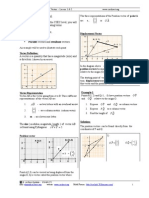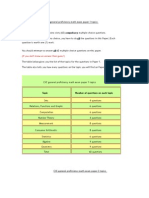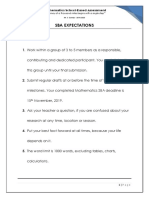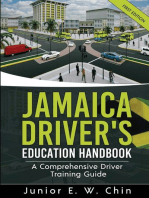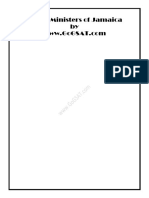Lesson 5-Consumer Arithmetic
Uploaded by
alessseLesson 5-Consumer Arithmetic
Uploaded by
alessseLESSON SUMMARY
CXC CSEC MATHEMATICS Lesson
UNIT Four:
Consumer Arithmetic
5
Mathematics for Buying, Selling, Borrowing
and Investing
Textbook: Mathematics, A Complete Course by Raymond Toolsie, Volume 1
(Some helpful exercises and page numbers are given throughout the lesson, e.g. Ex 5f page 182)
INTRODUCTION
As productive individuals, in our daily lives we are always involved in buying selling or
investing .There may also be times when we will have to take loans from a lending
institutions. This lesson deals with some of the important computational task involved in
these processes. It involves the application of the skills developed in the previous
lessons to our daily transactions. In buying or selling goods it is important to be able to
determine profit or loss and one should also be able to calculate interest from
investments made or the interest to be paid on a loan.
OBJECTIVES
At the end of this lesson you will be able to:
a) Calculate discount, sales tax, profit or loss
b) Solve problem involving marked price (or selling price), cost price,
percentage profit, loss or discount.
c) Solve problems involving payments by instalments as with hire purchase
and mortgages
d) Solve problem involving simple interest, compound interest, and
depreciation.
1 NOSTT CXC CSEC Mathematics Lesson Summary: Unit 4: Lesson 5
4.1 Profit and Loss, Discount
Profit and Loss
If a business man buys an article and sells it for more than what he paid for it he makes
a profit. If he sells the article for less than what he paid for it he makes a loss. The price
the business man pays for the article is called the cost price while the price he sells the
article for is called the selling price or marked price.
The following formulae will be helpful:
For Profit:
For Loss:
It follows from the above that given the profit per cent:
Try writing a formula for the loss given the loss per cent.
The above formulae can be used to solve the following examples.
Example: 1. A dealer buys 50 apples for $40 and sells them for $1.20 each. Calculate
his percentage profit. (Ex 5f page 182)
2 NOSTT CXC CSEC Mathematics Lesson Summary: Unit 4: Lesson 5
Solution:
= $60.
= 50%.
2.
$?
The cost price of a soccer ball is $65. If the loss per cent was 20%, what was the loss?
Also calculate the selling price.
Solution:
= $13.00
= $52.
Discount
3 NOSTT CXC CSEC Mathematics Lesson Summary: Unit 4: Lesson 5
A discount is a percentage off the selling price of an article given to a customer.
Therefore the customer buys the article at a reduced price (or sale price). Sometimes a
cash discount is given if a customer pays for an article in cash. Therefore the customer
pays the cash price for the article. The following formulae are useful:
Example:
1. A boutique is offering a 15% discount for cash. Calculate the cash price
for a dress with a marked price of $125. (Ex 5h page 185)
Solution: The discount = 15% of $125.
= $18.75
The cash price
= $106.25
2. In a sale, a cassette recorder was sold for $2071 after a discount of 5%
was given. Calculate the marked price of the cassette recorder.
Solution: the selling price is 95% of the marked price, i.e.
= $2180
ACTIVITY 1
4 NOSTT CXC CSEC Mathematics Lesson Summary: Unit 4: Lesson 5
1. Mr. Khan bought a refrigerator for $2 560. Calculate the selling price of the
refrigerator if he adds a profit of 20%. A 10% discount is offered for cash.
Calculate its cash price.
4.2 Simple and Compound Interest.
Simple Interest.
There are times when an individual will have to borrow money from a bank or invest
money in a bank. The amount borrowed or invested is called the principal. Interest is
charged on the principal at a given rate over the period of the loan. If the principal stays
the same over the period of the loan then the interest paid to the bank is simple interest.
If it is an investment and interest is not added to the principal during the period of the
investment, the principal remains the same. The interest paid to the investor here is also
simple interest.
The simple interest is given by .
P = the principal, i.e. the amount barrowed or deposited.
R = the rate of interest charged on the loan. This is charged as a certain per cent per
annum.
T = time, i.e. the length or period of the loan. If it’s a deposit, T is how long it remained
in the account. When using T in the calculation it must be in years. Therefore if T is
given as 6 months it is used as a year in the formula.
The principal is
Try and come up with the formulae for R and T.
The amount accruing,
Example:
1. A man invested $600 at 8% per annum simple interest for 5 years. (Ex 5s page 213)
5 NOSTT CXC CSEC Mathematics Lesson Summary: Unit 4: Lesson 5
Calculate:
(a) the simple interest payable.
(b) the total amount of money the man collected at the end of the 5-year period.
Solution:
a)
(Try working this with the per cent key on the calculator.)
b)
.
2. The simple interest on $15 000 for 9 years is $6750. Calculate the rate per cent per
annum.
Solution:
= 5% per annum.
Compound Interest.
If interest is added to the principal it grows. When interest is recalculated on the new
principal, the interest attracted here is called compound interest.
The compound interest formula is
A = the amount of money accruing after n years
P = the principal
6 NOSTT CXC CSEC Mathematics Lesson Summary: Unit 4: Lesson 5
R = the rate per cent per annum
n = the number of years for which the money was invested.
Also
Depreciation
The value of an asset such as a car depreciates every year. The depreciation formula
is: . The amount by which a value depreciates is given by
.
A = the value of the asset after n years.
P = the initial cost of the asset.
R = the rate of depreciation per annum.
n = the number of years for which the asset was depreciated.
Example:
1. Calculate the compound interest on investing $600 for 2 years at 7% per annum. (Ex
5t page 219)
Solution:
By using your calculator 1.07 2
= $686.94
Hence C.I. = $686.94− $600
7 NOSTT CXC CSEC Mathematics Lesson Summary: Unit 4: Lesson 5
= $86.94
2. Calculate the book value of a new maxi taxi costing $44 000 after 3 years if it
depreciates each year by 13%. (Ex 5u page 223)
Solution:
= $28 974.13
ACTIVITY 2
1. Which is the better investment?
(a) $1 200 at 9% simple interest for 2 years.
(b) $1 200 at 8% compound interest for 2 years.
2. Calculate the book value of a new mini bus costing $43 000 after 5 years if it
depreciates each year by 12%.
Sale tax, Hire purchase and mortgages
Sale tax
An example of sale tax is value added tax or VAT. This is a tax paid on goods and
services.
Example:
8 NOSTT CXC CSEC Mathematics Lesson Summary: Unit 4: Lesson 5
A DVD game player is priced at $2800 plus value added tax (VAT) at 15%. How many
dollars does the DVD game player actually cost the customer? (Ex 5i page 186)
Solution:
The customer pays (1 + of $2800
= 1.15
= $3220.
Hire purchase
This allows a customers to purchase much need goods with smaller monthly
instalments if they cannot immediately pay the full cash price. The customer usually
pays a down payment and interest is then added to the unpaid balance. The hire
purchase price is higher than the cash price.
Example:
The marked price of a freezer is $3000.00. There is a discount of 15% for cash
payment. To obtain the freezer on hire purchase, a deposit of $595.00 and 18 monthly
instalments of $159.50 each are required. (Ex 5j page 189)
Calculate:
a) The cash price
b) The total amount paid if bought on hire purchase
c) The difference between the cash price and the hire purchase price as a
percentage of the marked price.
Solution:
a) The cash price is 85% of $3000. (why?)
9 NOSTT CXC CSEC Mathematics Lesson Summary: Unit 4: Lesson 5
= $2550.
b)
= $3466.
c)
= $916.
=30.5%
Try to determine the interest charged in the above example.
Mortgage
This a long term loan a person obtains from a bank to purchase a car or a house. A
down payment is made to the owner of the house (or car) by the borrower and the bank
finances the balance.
A luxury apartment is priced at $235 000. An 85% mortgage can be obtained over a 20-
year period. (Ex 5k page 192)
Calculate:
a) the deposit payable
b) the loan amount needed
c) the total amount of money paid to the bank if each monthly payment was $2 829
d) the total amount paid for the house.
Solution:
a)
10 NOSTT CXC CSEC Mathematics Lesson Summary: Unit 4: Lesson 5
b)
c)
d)
ACTIVITY 3
CXC questions.
1. A store charges 6% VAT on all sales. What is the total cost of a shirt marked at
$30?
2.
Cash $600
Hire Purchase Plan:
11 NOSTT CXC CSEC Mathematics Lesson Summary: Unit 4: Lesson 5
Pay down $60
$55 monthly for 12 months
Mr Jones purchased the TV advertised in the diagram by using the hire
purchase plan instead of paying cash. How much more than $600 does Mr Jones
pay by using the hire purchase plan?
ASSESSMENT
1. A shopkeeper buys a stove from a manufacturer. The shopkeeper sells the stove for
$150.00 at a profit of 20%.
(a) How much did the shopkeeper pay the manufacturer for the stove?
(b) If the shopkeeper gives 10% discount for cash, how much does a
customer pay for the stove?
2. A man wishes to invest $1500. He can buy saving bonds which pay simple interest
at the rate of 8% per annum or he can start a savings account which pays
compound interest at the same rate. Calculate, to the nearest cent, the difference
between the amounts of the two investments at the end of 3 years.
CONCLUSION
We have looked at the basic arithmetic involved in buying, selling, making an
investments or securing a loan. We are also recipients of services for which we have to
pay rates. The following lesson looks at some basic Mathematics involved in
determining rates, including foreign exchange rates.
12 NOSTT CXC CSEC Mathematics Lesson Summary: Unit 4: Lesson 5
You might also like
- PDF Csec Mathematics June 2017 Paper 1 Solution 2017 CompressNo ratings yetPDF Csec Mathematics June 2017 Paper 1 Solution 2017 Compress9 pages
- Transformations Workbook For Csec MathematicsNo ratings yetTransformations Workbook For Csec Mathematics216 pages
- Consumer Arithmetic Multiple Choice CsecNo ratings yetConsumer Arithmetic Multiple Choice Csec3 pages
- Algebra, Relations, Functions and Graphs II100% (2)Algebra, Relations, Functions and Graphs II27 pages
- CXC Mathematics Tutorial: Author: John Spencer MBA (Dist), M. SC, B. SCNo ratings yetCXC Mathematics Tutorial: Author: John Spencer MBA (Dist), M. SC, B. SC9 pages
- Coordinate Geometry, Relations, Functions, Graphs and VariationsNo ratings yetCoordinate Geometry, Relations, Functions, Graphs and Variations30 pages
- CSEC Math Lesson 1 To 2 - Introduction To Sets and Sub-Sets100% (1)CSEC Math Lesson 1 To 2 - Introduction To Sets and Sub-Sets31 pages
- Caribbean Examinations Council: Caribbean Secondary Education Certificate Examination 07 JANUARY 2021 (A.m.)No ratings yetCaribbean Examinations Council: Caribbean Secondary Education Certificate Examination 07 JANUARY 2021 (A.m.)32 pages
- CXC General Proficiency Math Exam Paper 1 Topics100% (5)CXC General Proficiency Math Exam Paper 1 Topics3 pages
- CSEC MATHS - Mock Exam 2020 2 NEW SYLLABUSNo ratings yetCSEC MATHS - Mock Exam 2020 2 NEW SYLLABUS11 pages
- Percentages: UNIT 3 Using Fractions and CSEC Revision TestNo ratings yetPercentages: UNIT 3 Using Fractions and CSEC Revision Test2 pages
- Technology & The Global Business Environment'No ratings yetTechnology & The Global Business Environment'9 pages
- CSEC Mathematics SBA Guideline - MR Conlloyd GumbsNo ratings yetCSEC Mathematics SBA Guideline - MR Conlloyd Gumbs8 pages
- Jamaica Driver's Education Handbook: A Comprehensive Driver Training GuideFrom EverandJamaica Driver's Education Handbook: A Comprehensive Driver Training GuideNo ratings yet
- Cape Communication Studies: Practical Exercises for Paper 02 EssaysFrom EverandCape Communication Studies: Practical Exercises for Paper 02 EssaysNo ratings yet
- NEW Corporate Finance Online 1st Edition Eakins Test Bank - Download Today For Unlimited ReadingNo ratings yetNEW Corporate Finance Online 1st Edition Eakins Test Bank - Download Today For Unlimited Reading57 pages
- O'Neil Clarke Mathematics Institute Circle Theorem Questions0% (1)O'Neil Clarke Mathematics Institute Circle Theorem Questions4 pages
- Options Strategies For A Range Bound ViewNo ratings yetOptions Strategies For A Range Bound View11 pages
- UNIT 5 Standard Costing - Variance AnalysisNo ratings yetUNIT 5 Standard Costing - Variance Analysis50 pages
- INTACC 1 - REVIEWER - MIDTERMS (Receivables)No ratings yetINTACC 1 - REVIEWER - MIDTERMS (Receivables)3 pages
- Relationship Between Stock Market With Commodity Market in MalaysiaNo ratings yetRelationship Between Stock Market With Commodity Market in Malaysia20 pages
- India's Economic Geography in 2025 - States, Clusters and CitiesNo ratings yetIndia's Economic Geography in 2025 - States, Clusters and Cities76 pages
- (AFAR) (P01) - Job Order and Process Costing - PDFNo ratings yet(AFAR) (P01) - Job Order and Process Costing - PDF19 pages
- PDF Csec Mathematics June 2017 Paper 1 Solution 2017 CompressPDF Csec Mathematics June 2017 Paper 1 Solution 2017 Compress
- CXC Mathematics Tutorial: Author: John Spencer MBA (Dist), M. SC, B. SCCXC Mathematics Tutorial: Author: John Spencer MBA (Dist), M. SC, B. SC
- Coordinate Geometry, Relations, Functions, Graphs and VariationsCoordinate Geometry, Relations, Functions, Graphs and Variations
- CSEC Math Lesson 1 To 2 - Introduction To Sets and Sub-SetsCSEC Math Lesson 1 To 2 - Introduction To Sets and Sub-Sets
- Caribbean Examinations Council: Caribbean Secondary Education Certificate Examination 07 JANUARY 2021 (A.m.)Caribbean Examinations Council: Caribbean Secondary Education Certificate Examination 07 JANUARY 2021 (A.m.)
- Percentages: UNIT 3 Using Fractions and CSEC Revision TestPercentages: UNIT 3 Using Fractions and CSEC Revision Test
- CSEC Mathematics SBA Guideline - MR Conlloyd GumbsCSEC Mathematics SBA Guideline - MR Conlloyd Gumbs
- Jamaica Driver's Education Handbook: A Comprehensive Driver Training GuideFrom EverandJamaica Driver's Education Handbook: A Comprehensive Driver Training Guide
- Cape Communication Studies: Practical Exercises for Paper 02 EssaysFrom EverandCape Communication Studies: Practical Exercises for Paper 02 Essays
- NEW Corporate Finance Online 1st Edition Eakins Test Bank - Download Today For Unlimited ReadingNEW Corporate Finance Online 1st Edition Eakins Test Bank - Download Today For Unlimited Reading
- O'Neil Clarke Mathematics Institute Circle Theorem QuestionsO'Neil Clarke Mathematics Institute Circle Theorem Questions
- Relationship Between Stock Market With Commodity Market in MalaysiaRelationship Between Stock Market With Commodity Market in Malaysia
- India's Economic Geography in 2025 - States, Clusters and CitiesIndia's Economic Geography in 2025 - States, Clusters and Cities
- (AFAR) (P01) - Job Order and Process Costing - PDF(AFAR) (P01) - Job Order and Process Costing - PDF






















